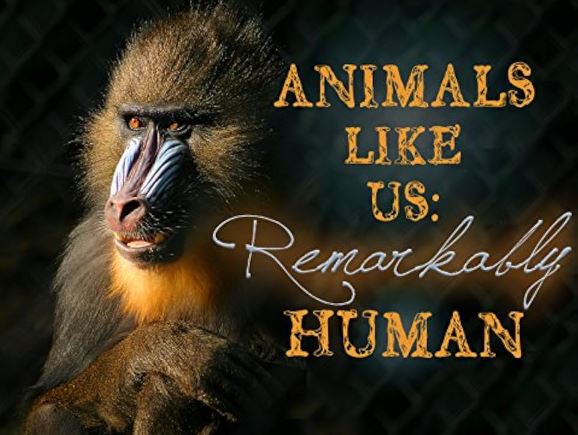What would “hello” be in tiger language? It’s “woof-woof.” This was said by a person who lived with tigers for a long time on a TV program. Since it was said casually by a foreigner, there is a possibility that I misheard it, and even if it’s correct, it could be a regional dialect and thus not authoritative. Many documentary-style programs on science and history are being aired. Compared to a while ago, there are now really incredible learning tools available. The National Geographic Channel aired a documentary series called “Animal Like Us” in 2007. It was a program that observed the animal world similar to humans. This program showed animals using language and tools. The animals featured in the program discipline problematic members of their society collectively and also form alliances for political purposes. They are social, in other words. We might not have noticed because of our limited observational skills, but they communicate, feel jealousy, forgive, and reconcile.

National Geographic Humans can no longer be considered the only “political animals” as defined by Aristotle. The report also includes observations that animals’ use of tools, such as passing on the methods to the next generation, could be cultural. This level of observation forces us to acknowledge our ignorance of nature until now.
In Sun Tzu’s “The Art of War,” the strategy section, known as “Attack by Stratagem” or “Mou Gong,” includes the saying “know thy enemy and know thyself.” The enemy here literally means the opponent you have to fight. However, in everyday life, we don’t know who our enemies are or who we have to fight against. It may not even be clear that we have to fight. In a modern interpretation, the “enemy” or “bi” in “know thy enemy” should encompass everything other than oneself. This includes not only the immediate adversary but also the natural environment, changing times, and the resulting uncertainties. Ultimately, “knowing thy enemy” means understanding humans and the world. The most important reason to understand other beings apart from oneself is to adapt to the environment and survive, but we also learn a lot from nature.
In reality, the history of science and technology can be considered a history of mimicking nature. Developing new technologies by imitating nature began with the birth of humanity. Hunting tools like knives and arrowheads used in primitive times were probably made by imitating the sharp claws and teeth of carnivores. The wheel, one of the most important inventions in human history, might have been inspired by rolling logs or round stones. Some spiders even roll their bodies into balls to escape. The Wright brothers’ airplane imitated birds, the ship’s propeller mimicked a dolphin’s tail, and the autopilot system of airplanes was modeled after a bird’s nervous system. Humans have continually invented machines that complement human abilities by mimicking natural life forms. The development of technology through the imitation of nature is far from over. There’s even a dedicated field called biomimicry, and more ambitiously, Nature-Inspired Engineering, where scholars aim to formally imitate nature.
These scholars now seem particularly interested in the nanostructures found in nature. For example, gecko lizards can climb walls remarkably well despite being much heavier than flies or mosquitoes and having smooth feet. This is because their feet have billions of tiny hairs, each between 200 nm and 500 nm thick. No adhesive substances are secreted from a gecko’s feet. Nevertheless, the gecko exhibits strong adhesive power due to the van der Waals forces acting between the billions of tiny hairs and the wall surface. Now, scientists are closely examining gecko feet to develop dry adhesives that do not require glue.
Humans learn more than just technology from nature. We learn humility, perseverance, and the principles of coexistence. Since humans are part of nature, we are not independent of nature’s principles. We learn from nature and live within it. Harvard professor Edward O. Wilson boldly predicted in his 1975 book “Sociobiology: The New Synthesis” that social sciences would become a branch of biology in the near future. He argued that human life is not significantly different from that of other organisms. In fact, Wilson’s words seem to have evolved from Charles Darwin’s prediction in “The Origin of Species” that “psychology will be based on a new foundation.” Pre-Socratic Western philosophy considered living nature as the object of thought and was called natural philosophy. Isaac Newton, often considered the greatest scientist in history, also saw himself as a natural philosopher. The title of his collection of papers, “The Mathematical Principles of Natural Philosophy,” proves this.
Nevertheless, people have long distinguished between matter and living things and separated humans from other organisms. This might have been to maintain human dignity and superiority or simply due to ignorance. We might have mistakenly believed that only humans live by will, even though all organisms in this universe have the will to survive and reproduce, existing as members of a greater whole. On the other hand, some environmentalists nowadays exclude humans from the ecosystem, criticizing human ignorance and greed while trying to preserve the dignity of nature. Although humans may be the most harmful beings in the ecosystem, it doesn’t change the fact that humans are part of it.
Our world, including ourselves, is complex but not chaotic. A few rules or principles we know prove this. Perhaps the world operates on some perfect principles that we humans have yet to discover. People have long searched for such principles. Laozi defined the absolute and true principle of nature that makes all things exist and have value as the “Tao.” The problem is that Laozi’s Tao cannot be perceived through sensory experience. Laozi’s Tao is something that “cannot be seen even if you want to see it, cannot be heard even if you want to hear it, and cannot be grasped even if you want to grasp it.” We need more concrete natural principles than Laozi’s Tao.
Some of these principles have now revealed themselves to us through many great minds. So, how did they understand nature and realize the principles of the world? In fact, we learned this methodology unknowingly while acquiring knowledge about nature during our school days. To put it simply, the methodology involves analyzing, imagining, and integrating. Analysis fundamentally means observing objects by breaking them down. Focusing and looking closely makes it easier to understand the principles.
Natural sciences, in particular, focus on analysis. Analysis means breaking down a whole into parts and elements. For example, to understand seawater, we first need to look at what it’s made of. While breaking down seawater itself is science, such methods reveal that seawater has a salinity of about 3.5%, with sodium chloride being the most abundant component. We can further divide salt into sodium (Na) and chlorine (Cl). Through this process, we understand the relationship between the pieces and the whole. For instance, if we understand that the saltiness of seawater is due to sodium chloride, we’ve identified a causal relationship. Sodium chloride, in other words, is salt.
Although causal relationships are the most important, not everything is composed of cause and effect. By comparing similarities and differences between the pieces, we can identify some other relationships. This is analysis. Analysis is also related to our thinking ability. As mentioned several times in “know thyself,” we are not good at thinking about many elements simultaneously. Most real-world problems are complex phenomena, but thinking about them all at once is confusing. On the other hand, understanding complex phenomena by breaking them down into a few elements makes it easier to explain the whole. Many objects and various phenomena begin to reveal their “secret codes” through such analysis, albeit not completely.
The problem with analyzing by breaking things down is that we might lose part of the original essence. The essence of objects or natural phenomena is not merely the sum of their parts but is created by the interactions between them. Having relationships between elements means they are composed not just by simple addition but by multiplication functions. To understand those relationships, we need to imagine what form of multiplication it could be. We detect a characteristic and draw the whole picture or estimate unseen relationships. Through analysis, we might have significantly distorted reality. Imagination helps create a “road of imagination” from a simplified model back to reality. Of course, this process might again twist our reality. Through trial and error, our understanding deepens. Finally, we need to integrate the parts to create a new whole. This process is called synthesis. Synthesis is the work of piecing together important facts obtained through analysis. Through the principles and laws derived from such processes, we understand and explain the whole. In this sense, synthesis gives us insight.
For a while, not only natural sciences but also social sciences were so engrossed in their achievements that they were too busy following their own paths. Consequently, knowledge started to fragment at an increasingly rapid pace. There are many experts in specific areas, but it’s hard to find people who understand the whole picture. However, this situation doesn’t last long. The importance of synthesis is being emphasized again, and some are implementing it. This applies to both academic research and everyday thinking. To understand this complex world, we must repeatedly analyze and synthesize. When faced with the unknown, we separate and think, then integrate again as we start to understand the relationships. When we encounter complexity again, we start to separate once more. Imagination finds the connecting link between analysis and synthesis. This is how we understand nature, or “know thy enemy,” and through this process, we develop our unique perspective or view of the world. Wisdom and worldview are thus obtained.


답글 남기기